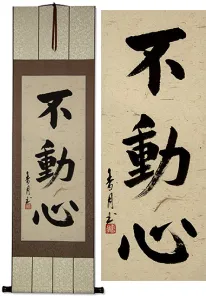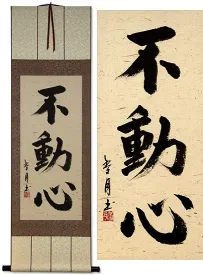Many custom options...
And formats...

Not what you want?
Try other similar-meaning words, fewer words, or just one word.
Feel free to email me with your request. If it's easy, I'll translate it for free and add it to this database of calligraphy for you.
Immovable Liberation in Chinese / Japanese...
Buy an Immovable Liberation calligraphy wall scroll here!
Immovable Liberation
不動解脫 is a Buddhist term that refers to liberation from being disturbed by the illusions of life.
In short, this can be called “immovable liberation.”
This allows one to remain unaffected by the impermanent things such as emotions, attachments, desires, and greed of the world.
This in-stock artwork might be what you are looking for, and ships right away...
Gallery Price: $200.00
Your Price: $118.88
Gallery Price: $200.00
Your Price: $118.88
Not the results for Immovable Liberation that you were looking for?
Below are some entries from our dictionary that may match your Immovable Liberation search...
| Characters If shown, 2nd row is Simp. Chinese |
Pronunciation Romanization |
Simple Dictionary Definition |
不動解脫 不动解脱 see styles |
bù dòng jiě tuō bu4 dong4 jie3 tuo1 pu tung chieh t`o pu tung chieh to fudō gedatsu |
More info & calligraphy: Immovable Liberation |
不動阿羅漢 不动阿罗汉 see styles |
bù dòng ā luó hàn bu4 dong4 a1 luo2 han4 pu tung a lo han fudō arakan |
an arhat who has attained to the state of the immovable liberation 不動解脫. |
The following table may be helpful for those studying Chinese or Japanese...
| Title | Characters | Romaji (Romanized Japanese) | Various forms of Romanized Chinese | |
| Immovable Liberation | 不動解脫 不动解脱 | fudō gedatsu fudōgedatsu | bù dòng jiě tuō bu4 dong4 jie3 tuo1 bu dong jie tuo budongjietuo | pu tung chieh t`o putungchiehto pu tung chieh to |
| In some entries above you will see that characters have different versions above and below a line. In these cases, the characters above the line are Traditional Chinese, while the ones below are Simplified Chinese. | ||||
Successful Chinese Character and Japanese Kanji calligraphy searches within the last few hours...






